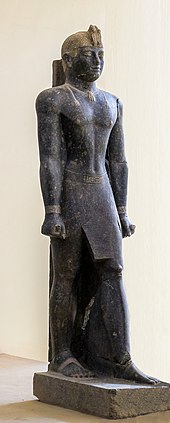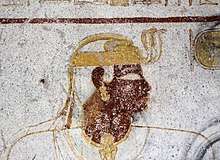Twenty-fifth Dynasty of Egypt
The Twenty-fifth Dynasty of Egypt (notated Dynasty XXV, alternatively 25th Dynasty or Dynasty 25), also known as the Nubian Dynasty or the Kushite Empire, was the last dynasty of the Third Intermediate Period of Egypt that occurred after the Nubian invasion.
Twenty-fifth dynasty of Egypt | |||||||||||||||||
|---|---|---|---|---|---|---|---|---|---|---|---|---|---|---|---|---|---|
| 744 BC–656 BC | |||||||||||||||||
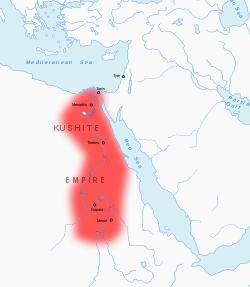 Kushite Empire in 700 BC | |||||||||||||||||
| Capital | Napata Memphis | ||||||||||||||||
| Common languages | Egyptian, Meroitic | ||||||||||||||||
| Religion | ancient Egyptian religion | ||||||||||||||||
| Government | Monarchy | ||||||||||||||||
| Pharaoh | |||||||||||||||||
• 744–714 BC | Piye (first) | ||||||||||||||||
• 664–656 BC | Tantamani (last) | ||||||||||||||||
| History | |||||||||||||||||
• Established | 744 BC | ||||||||||||||||
• Disestablished | 656 BC | ||||||||||||||||
| |||||||||||||||||

The 25th dynasty was a line of pharaohs who originated in the Kingdom of Kush, located in present-day northern Sudan and Upper Egypt. Most of this dynasty's kings saw Napata as their spiritual homeland. They reigned in part or all of Ancient Egypt from 744–656 BC.[2] The dynasty began with Kashta's invasion of Upper Egypt and culminated in several years of both successful and unsuccessful wars with the Mesopotamia-based Neo-Assyrian Empire. The 25th Dynasty's reunification of Lower Egypt, Upper Egypt, and Kush created the largest Egyptian empire since the New Kingdom. They assimilated into society by reaffirming Ancient Egyptian religious traditions, temples, and artistic forms, while introducing some unique aspects of Kushite culture.[3] It was during the 25th dynasty that the Nile valley saw the first widespread construction of pyramids (many in what is now Sudan) since the Middle Kingdom.[4][5][6]
After the emperors Sargon II and Sennacherib defeated attempts by the Nubian kings to gain a foothold in the Near East, their successors, Esarhaddon and Ashurbanipal , invaded, defeated and drove out the Nubians. War with Assyria resulted in the end of Kushite power in Northern Egypt and the conquest of Egypt by the Neo-Assyrian Empire. They were succeeded by the Twenty-sixth Dynasty, initially a puppet dynasty installed by and vassals of the Assyrians, the last native dynasty to rule Egypt before the Achaemenid Empire invaded them. The fall of the Twenty-fifth Dynasty also marks the beginning of the Late Period of ancient Egypt.
History
Piye
The twenty-fifth dynasty originated in Kush, which is presently in Northern Sudan. The city-state of Napata was the spiritual capital and it was from there that Piye (spelled Piankhi or Piankhy in older works) invaded and took control of Egypt.[7] Piye personally led the attack on Egypt and recorded his victory in a lengthy hieroglyphic filled stele called the "Stele of Victory." Piye revived one of the greatest features of the Old and Middle Kingdoms, pyramid construction. An energetic builder, he constructed the oldest known pyramid at the royal burial site of El-Kurru and expanded the Temple of Amun at Jebel Barkal.[5] Although Manetho does not mention the first king, Piye, mainstream Egyptologists consider him the first Pharaoh of the 25th dynasty.[4][5][6][8] Manetho also does not mention the last king, Tantamani, although inscriptions exist to attest to the existence of both Piye and Tantamani.
Piye made various unsuccessful attempts to extend Egyptian influence in the Near East, then controlled from Mesopotamia by the Semitic Assyrian Empire. In 720 BC he sent an army in support of a rebellion against Assyria in Philistia and Gaza, however, Piye was defeated by Sargon II, and the rebellion failed.[9]
Shebitku
Shebitku conquered the entire Nile Valley, including Upper and Lower Egypt, around 712 BC. Shebitku had Bocchoris of the preceding Sais dynasty burned to death for resisting him. After conquering Lower Egypt, Shebitku transferred the capital to Memphis.[10] Dan'el Kahn suggested that Shebitku was king of Egypt by 707/706 BC.[11] This is based on evidence from an inscription of the Assyrian king Sargon II, which was found in Persia (then a colony of Assyria) and dated to 706 BC. This inscription calls Shebitku the king of Meluhha, and states that he sent back to Assyria a rebel named Iamanni in handcuffs. Kahn's arguments have been widely accepted by many Egyptologists including Rolf Krauss, and Aidan Dodson[12] and other scholars at the SCIEM 2000 (Synchronisation of Civilisations of the Eastern Mediterranean in the Second Millennium B.C.) project with the notable exception of Kenneth Kitchen and Manfred Bietak at present.
Although the Manethonic and classical traditions maintain that it was Shebitku's invasion which brought Egypt under Kushite rule, the king burning his opponent, Bocchoris-Bakenranef, alive, there is no direct evidence that Shabaqo did slay Bakenranef, and although earlier scholarship generally accepted the tradition, it has recently been treated more sceptically.[13]
Shabaka

Shabaka "brought the entire Nile Valley as far as the Delta under the empire of Kush and is reputed to have had Bocchoris, dynast of Sais, burnt to death."[4] Shabaka restored the great Egyptian monuments and returned Egypt to a theocratic monarchy by becoming the first priest of Amon. In addition, Shabaka is known for creating a well-preserved example of Memphite theology by inscribing an old religious papyrus into the Shabaka Stone. Shabaka supported an uprising against the Assyrians in the Philistine city of Ashdod, however he and his allies were defeated by Sargon II.
The most recent archaeological evidence shows that Shabaka ruled Egypt after Shebitku and not before—as previously thought. The construction of the tomb of Shebitku (Ku. 18) resembles that of Piye (Ku. 17) while that of Shabaka (Ku. 15) is similar to that of Taharqa (Nu. 1) and Tantamani (Ku. 16) [39 – D. Dunham, El-Kurru, The Royal Cemeteries of Kush, I, (1950) 55, 60, 64, 67; also D. Dunham, Nuri, The Royal Cemeteries of Kush, II, (1955) 6–7; J. Lull, Las tumbas reales egipcias del Tercer Periodo Intermedio (dinastías XXI-XXV). Tradición y cambios, BAR-IS 1045 (2002) 208.] .[14] Secondly, Payraudeau notes in French that "the Divine Adoratrix Shepenupet I, the last Libyan Adoratrix, was still alive during the reign of Shebitku because she is represented performing rites and is described as "living" in those parts of the Osiris-Héqadjet chapel built during his reign (wall and exterior of the gate) [45 – G. Legrain, "Le temple et les chapelles d’Osiris à Karnak. Le temple d’Osiris-Hiq-Djeto, partie éthiopienne", RecTrav 22 (1900) 128; JWIS III, 45.].[14] In the rest of the room it is Amenirdis I, (Shabaka's sister), who is represented with the Adoratrix title and provided with a coronation name. The succession Shepenupet I - Amenirdis I thus took place during the reign of Shebitku/Shabataqo. This detail in itself is sufficient to show that the reign of Shabaka cannot precede that of Shebitku/Shabataqo.[14] Finally, Gerard Broekman's GM 251 (2017) paper shows that Shebitku reigned before Shabaka since the upper edge of Shabaka's NLR #30's Year 2 Karnak quay inscription was carved over the left-hand side of the lower edge of Shebitku's NLR#33 Year 3 inscription.[10] This can only mean that Shabaka ruled after Shebitku
Taharqa
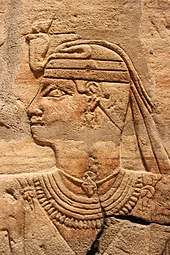
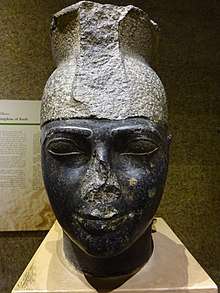
_%2C_Kerma_Museum%2CSudan_(2).jpg)
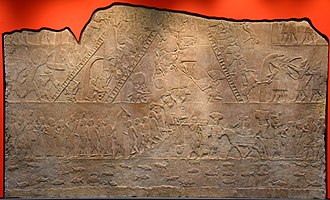
From 690 BC[2], Taharqa ruled Upper and Lower Egypt as Pharaoh from Tanis in the Delta.[16][4] Taharqa's reign was a prosperous time in the empire with a particularly large Nile river flood and abundant crops and wine.[17][2] Taharqa's inscriptions indicate that he gave large amounts of gold to the temple of amun at Kawa.[18] He restored and constructed great works throughout the Nile Valley, including works at Jebel Barkal, Kawa (with Lebanese cedar)[2], Qasr Ibrim, and Karnak.[19][20] "Thebes was enriched on a monumental scale."[2] At Karnak, the Sacred Lake structures, the kiosk in the first court, and the colonnades at the temple entrance are all owed to Taharqa and Mentuemhet. Taharqa and the Kushites marked a renaissance in Pharaonic art.[21] Taharqa built the largest pyramid (52 square meters at base) in the Nubian region at Nuri (near El-Kurru) with the most elaborate Kushite rock-cut tomb.[22] Taharqa was buried with "over 1070 shabtis of varying sizes and made of granite, green ankerite, and alabaster."[23]
Taharqa's army undertook successful military campaigns, as attested by the "list of conquered Asiatic principalities" from the Mut temple at Karnak and "conquered peoples and countries (Libyans, Shasu nomads, Phoenicians?, Khor in Palestine)" from Sanam temple inscriptions.[2] Imperial ambitions of the Mesopotamian based Assyrian Empire made war with the 25th dynasty inevitable. In 701 BC, Taharqa and his army aided Judah and King Hezekiah in withstanding a siege by King Sennacherib of the Assyrians (2 Kings 19:9; Isaiah 37:9)[24]. There are various theories (Taharqa's army[25], disease, divine intervention, Hezekiah's surrender) as to why the Assyrians failed to take the city and withdrew to Assyria.[26] However, Sennacherib's annals record Judah was forced into tribute after the siege.[9] Many historians claim that Sennacherib was the overlord of Khor following the seige in 701 BC. However, this is contradicted by Khor's frequent utilization of an Egyptian system of weights for trade[27], the 20 year cessation in Assyria's pattern (before 701 and after Sennacherib's death) of repeatedly invading Khor[28], and Taharqa flouting Assyria's ban on Lebanese cedar exports to Egypt, while Taharqa was building his temple to amun at Kawa.[29] Sennacherib was murdered by his own sons in revenge for the destruction of the rebellious Mesopotamian city of Babylon, a city sacred to all Mesopotamians, the Assyrians included.
In 679 BC, Sennacherib's successor, King Esarhaddon, campaigned into Khor and took a town loyal to Egypt. After destroying Sidon and forcing Tyre into tribute in 677-676 BC, Esarhaddon invaded Egypt in 674 BC. Taharqa and his army defeated the Assyrians outright in 674 BC, according to Babylonian records.[30] Taharqa's Egypt still held sway in Khor during this period as evidenced by Esarhaddon's 671 BC annal mentioning that Tyre's King Ba'lu had "put his trust upon his friend Taharqa", Ashkelon's alliance with Egypt, and Esarhaddon's inscription asking "if the Egyptian forces will defeat Esarhaddon at Ashkelon."[31] However, Taharqa was defeated in Egypt in 671 BC when Esarhaddon conquered Northern Egypt, captured Memphis, imposed tribute, and then withdrew.[16] In 669 BC, Taharqa reoccupied Memphis, as well as the Delta, and recommenced intrigues with the king of Tyre.[16] Esarhaddon again led his army to Egypt and on his death, the command passed to Ashurbanipal. Ashurbanipal and the Assyrians advanced as far south as Thebes, but direct Assyrian control was not established."[16]
Taharqa remains an important historical figure in Sudan and elsewhere, as is evidenced by Will Smith's recent project to depict Taharqa in a major motion picture.[32] As of 2017, the status of this project is unknown.
A study of the sphinx that was created to represent Taharqa indicates that he was a Kushite pharaoh from Nubia.[33]
Tantamani
His successor, Tantamani, regained control of Egypt, as far north as Memphis.[16] He proceeded north from Napata through to Elephantine and Thebes with a large army, defeating and killing Necho I in Memphis. Necho was then an Egyptian vassal in the Delta region, ruling over Sais as a vassal of Ashurbanipal. Tantamani proceeded north of Memphis, invading Lower Egypt and, besieged cities in the Delta, a number of which surrendered to him.
Necho's son Psamtik I had fled Egypt to Assyria and soon after returned with Ashurbanipal and a large army comprising Carian mercenaries. Tantamani was routed somewhere north of Memphis. Tantamani fled to Thebes but less than 40 days later, the Assyrians arrived. Tantamani escaped back to Nubia, and in 663 BC the Assyrian army sacked Thebes "and devastated the area."[16] As the sole native Egyptian ruler loyal to Assyrians since the days of Esarhaddon, Psamtik I was placed on the throne of Lower Egypt as a vassal of Ashurbanipal. Psamtik quickly unified Lower Egypt under his aegis, becoming the first ruler of the Twenty-Sixth Dynasty. In 656 BC, Psamtik sent a large fleet southwards to Thebes, peacefully taking control of the still rebellious Upper Egypt thereby unifying all of Egypt.
Tantamani and the Nubians never again posed a threat to either Assyria or Egypt. Upon his death, Tantamani was buried in the royal cemetery of El-Kurru, upstream from the Kushite capital of Napata. He was succeeded by a son of Taharqa, king Atlanersa.[9]
The Twenty-fifth Dynasty ruled for a little more than one hundred years. The successors of the Twenty-fifth Dynasty settled back in their Nubian homeland, where they established a kingdom at Napata (656–590 BC), then, later, at Meroë (590 BC – 4th century AD).
Revenge of Psamtik II
Psamtik II, the third ruler of the following dynasty, the Twenty-Sixth Dynasty, deliberately destroyed monuments belonging to the 25th Dynasty of Kushite kings in Egypt, erasing their names and their emblems of royalty from statues and reliefs in Egypt. He then sent an army to Nubia in 592 BCE to erase all traces of their rule, during the reign of the Kushite King Aspelta. This expedition and its destructions are recorded on several victory stelae, especially the Victory Stela of Kalabsha. The Egyptian army advanced to the capital city of Napata, looting and destroying all they found. This led to the transfer of the Kushite capital farther south at Meroë.[34][35]
Art and architecture
Although the Twenty-Fifth Dynasty controlled Ancient Egypt for only 73 years (744–671 BC), it holds an important place in Egyptian history due to the restoration of traditional Egyptian values, culture, art, and architecture.
 Relief of a High Official, c. 670–650 BC. 1996.146.3, Brooklyn Museum; This relief's style makes it possible to attribute it to one of the palatial tombs of Dynasty XXV and Dynasty XXVI built by great officials such as Montuemhat, governor of Upper Egypt.
Relief of a High Official, c. 670–650 BC. 1996.146.3, Brooklyn Museum; This relief's style makes it possible to attribute it to one of the palatial tombs of Dynasty XXV and Dynasty XXVI built by great officials such as Montuemhat, governor of Upper Egypt. Kashta, sometimes considered the first King of the 25th dynasty, took control of parts of Upper Egypt and installed his daughter Amenirdis I as Chief Priestess of Amun at Thebes. Above are the names of Amenirdis (left) and Kashta (right).
Kashta, sometimes considered the first King of the 25th dynasty, took control of parts of Upper Egypt and installed his daughter Amenirdis I as Chief Priestess of Amun at Thebes. Above are the names of Amenirdis (left) and Kashta (right).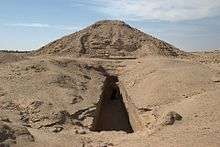 Piye was a Nubian king who conquered Upper Egypt and brought it under his control. During the 25th dynasty Egypt was ruled from Napata. Pictured is his pyramid at Al Kurru, Sudan.
Piye was a Nubian king who conquered Upper Egypt and brought it under his control. During the 25th dynasty Egypt was ruled from Napata. Pictured is his pyramid at Al Kurru, Sudan. Kneeling statuette of a man with a seated figure of Osiris between his thighs. Steatite. Nubian 25th Dynasty. From Saqqara, H5-105, Egypt. The Petrie Museum of Egyptian Archaeology, London
Kneeling statuette of a man with a seated figure of Osiris between his thighs. Steatite. Nubian 25th Dynasty. From Saqqara, H5-105, Egypt. The Petrie Museum of Egyptian Archaeology, London 25th Dynasty royal monumental statues from Doukki-Gel.
25th Dynasty royal monumental statues from Doukki-Gel.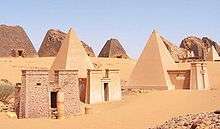
Pharaohs of the 25th Dynasty
The pharaohs of the 25th Dynasty ruled for approximately seventy-three years in Egypt, from 744 BC to 671 BC.
| Pharaoh | Image | Throne Name | Reign | Pyramid | Consort(s) | Comments |
|---|---|---|---|---|---|---|
| Piye | 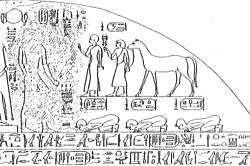 | Usimare | c. 744–714 BC | Kurru 17 | Tabiry (Kurru 53) Abar (Nuri 53?) Khensa (Kurru 4) Peksater (Kurru 54) Nefrukekashta (Kurru 52) |
Kashta is sometimes considered the first pharaoh of the dynasty, as opposed to Piye. |
| Shebitku |  |
Djedkare | 714–705 BC | Kurru 18 | Arty (Kurru 6) | |
| Shabaka |  |
Nefer-ka-re | 705–690 BC | Kurru 15 | Qalhata (Kurru 5) Mesbat Tabekenamun? |
|
| Taharqa |  | Khunefertumre | 690–664 BC | Nuri 1 | Takahatenamun (Nuri 21?) Atakhebasken (Nuri 36) Naparaye (Kurru 3) Tabekenamun? |
|
| Tantamani |  | Bakare | 664–656 BC | Kurru 16 | Piankharty [..]salka Malaqaye? (Nuri 59) |
Lost control of Upper Egypt in 656 BC when Psamtik I captured Thebes in that year. |
The period starting with Kashta and ending with Malonaqen is sometimes called the Napatan Period. The later Kings from the twenty-fifth dynasty ruled over Napata, Meroe, and Egypt. The seat of government and the royal palace were in Napata during this period, while Meroe was a provincial city. The kings and queens were buried in El-Kurru and Nuri.[36]
Alara, the first known Nubian king and predecessor of Kashta was not a 25th dynasty king since he did not control any region of Egypt during his reign. While Piye is viewed as the founder of the 25th dynasty, some publications may include Kashta who already controlled some parts of Upper Egypt. A stela of his was found at Elephantine and Kashta likely exercised some influence at Thebes (although he did not control it) since he held enough sway to have his daughter Amenirdis I adopted as the next Divine Adoratrice of Amun there.
Timeline of the 25th Dynasty

See also
| Periods and Dynasties of Ancient Egypt | ||||||||||||||||||
|---|---|---|---|---|---|---|---|---|---|---|---|---|---|---|---|---|---|---|
|
All years are BC | ||||||||||||||||||
|
Early
|
||||||||||||||||||
|
||||||||||||||||||
|
||||||||||||||||||
|
||||||||||||||||||
|
||||||||||||||||||
|
||||||||||||||||||
|
||||||||||||||||||
|
||||||||||||||||||
|
Ptolemaic (Hellenistic)
|
||||||||||||||||||
|
See also: List of Pharaohs by Period and Dynasty Periodization of Ancient Egypt | ||||||||||||||||||
- History of Ancient Egypt
- List of monarchs of Kush
- Twenty-fifth dynasty of Egypt family tree
References
- Elshazly, Hesham. "Kerma and the royal cache". Cite journal requires
|journal=(help) - Török, László (1998). The Kingdom of Kush: Handbook of the Napatan-Meroitic Civilization. Leiden: BRILL. p. 132-133,170-184. ISBN 90-04-10448-8.
- Bonnet, Charles (2006). The Nubian Pharaohs. New York: The American University in Cairo Press. pp. 142–154. ISBN 978-977-416-010-3.
- Mokhtar, G. (1990). General History of Africa. California, USA: University of California Press. pp. 161–163. ISBN 0-520-06697-9.
- Emberling, Geoff (2011). Nubia: Ancient Kingdoms of Africa. New York: Institute for the Study of the Ancient World. pp. 9–11. ISBN 978-0-615-48102-9.
- Silverman, David (1997). Ancient Egypt. New York: Oxford University Press. pp. 36–37. ISBN 0-19-521270-3.
- Herodotus (2003). The Histories. Penguin Books. pp. 106–107, 133–134. ISBN 978-0-14-044908-2.
- Mokhtar, G. (1990). General History of Africa. California, USA: University of California Press. p. 67. ISBN 0-520-06697-9.
- Roux, Georges (1992). Ancient Iraq (Third ed.). London: Penguin. ISBN 0-14-012523-X.
- Broekman, Gerard P. F. (2017). "Genealogical considerations regarding the kings of the Twenty-fifth Dynasty in Egypt". Göttinger Miszellen. 251: 13–20. ISSN 0344-385X.
- Kahn, Dan'el (2001). "The Inscription of Sargon II at Tang-i Var and the Chronology of Dynasty 25". Orientalia. 70 (1): 1–18. JSTOR 43076732.
- Sidebotham, Steven E. (2002). "Newly Discovered Sites in the Eastern Desert". Journal of Egyptian Archaeology. 82: 181–192 [p. 182 n. 24]. JSTOR 3822121.
- Wenig, Steffen (1999). Studien Zum Antiken Sudan: Akten Der 7. Internationalen Tagung Für Meroitische Forschungen Vom 14. Bis 19. September 1992 in Gosen/bei Berlin. Otto Harrassowitz Verlag. p. 203. ISBN 9783447041393.
- Payraudeau, F. (2014). "Retour sur la succession Shabaqo-Shabataqo" (PDF). Nehet. 1: 115–127.
- "Wall panel; relief British Museum". The British Museum.
- Welsby, Derek A. (1996). The Kingdom of Kush. London, UK: British Museum Press. pp. 64–65. ISBN 071410986X.
- Welsby, Derek A. (1996). The Kingdom of Kush. London, UK: British Museum Press. p. 158. ISBN 071410986X.
- Welsby, Derek A. (1996). The Kingdom of Kush. London, UK: British Museum Press. p. 169. ISBN 071410986X.
- Welsby, Derek A. (1996). The Kingdom of Kush. London, UK: British Museum Press. pp. 16–34, 62–64, 175, 183. ISBN 071410986X.
- Diop, Cheikh Anta (1974). The African Origin of Civilization. Chicago, Illinois: Lawrence Hill Books. pp. 219–221. ISBN 1-55652-072-7.
- Welsby, Derek A. (1996). The Kingdom of Kush. London, UK: British Museum Press. p. 178. ISBN 071410986X.
- Welsby, Derek A. (1996). The Kingdom of Kush. London, UK: British Museum Press. pp. 103, 107–108. ISBN 071410986X.
- Welsby, Derek A. (1996). The Kingdom of Kush. London, UK: British Museum Press. p. 87. ISBN 071410986X.
- Aubin, Henry T. (2002). The Rescue of Jerusalem. New York, NY: Soho Press, Inc. pp. x, 141–144. ISBN 1-56947-275-0.
- Aubin, Henry T. (2002). The Rescue of Jerusalem. New York, NY: Soho Press, Inc. pp. x, 127, 129–130, 139–152. ISBN 1-56947-275-0.
- Aubin, Henry T. (2002). The Rescue of Jerusalem. New York, NY: Soho Press, Inc. pp. x, 119. ISBN 1-56947-275-0.
- Aubin, Henry T. (2002). The Rescue of Jerusalem. New York, NY: Soho Press, Inc. pp. x, 155–156. ISBN 1-56947-275-0.
- Aubin, Henry T. (2002). The Rescue of Jerusalem. New York, NY: Soho Press, Inc. pp. x, 152–153. ISBN 1-56947-275-0.
- Aubin, Henry T. (2002). The Rescue of Jerusalem. New York, NY: Soho Press, Inc. pp. x, 155. ISBN 1-56947-275-0.
- Aubin, Henry T. (2002). The Rescue of Jerusalem. New York, NY: Soho Press, Inc. pp. x, 158–161. ISBN 1-56947-275-0.
- Aubin, Henry T. (2002). The Rescue of Jerusalem. New York, NY: Soho Press, Inc. pp. x, 159–161. ISBN 1-56947-275-0.
- Fleming, Michael (September 7, 2008). "Will Smith puts on 'Pharaoh' hat". Variety. Retrieved July 23, 2016.
- Nöthling, F. J. (1989). Pre-Colonial Africa: Her Civilisations and Foreign Contacts. Southern Book Publishers. p. 43. Retrieved 2 April 2018.
He moved his capital to Thebes and became king of Kush and Misr (Egypt) forming the 25th dynasty. Kushite power stretched from the Mediterranean Sea to the present Ethiopian boundary. Some Egyptians welcomed the Kushite presence and saw them as civilised people and not as barbarians. Their culture was a mixture of indigenous Egyptian and Sudanese elements and physically their appearance included Egyptian, Berber-Libyan and other Mediterranean elements as well as the Negroid blood coming from the region of the fifth and sixth cataracts
- Leahy, Anthony (1992). "Royal Iconography and Dynastic Change, 750-525 BC: The Blue and Cap Crowns". The Journal of Egyptian Archaeology. 78: 238. doi:10.2307/3822074. ISSN 0307-5133.
- Elshazly, Hesham. "Kerma and the royal cache": 26–77. Cite journal requires
|journal=(help) - Dunham, Dows (1946). "Notes on the History of Kush 850 BC-A. D. 350". American Journal of Archaeology. 50 (3): 378–388. JSTOR 499459.
Further reading
- Reisner, G. A. (1919). "Discovery of the Tombs of the Egyptian XXVth Dynasty". Sudan Notes and Records. 2 (4): 237–254. JSTOR 41715805.
- Morkot, R. G. (2000). The Black Pharaohs, Egypt's Nubian Rulers. London: Rubicon Press.
External links
- (in French) Voyage au pays des pharaons noirs Travel in Sudan : pictures and notes on the Nubian history
